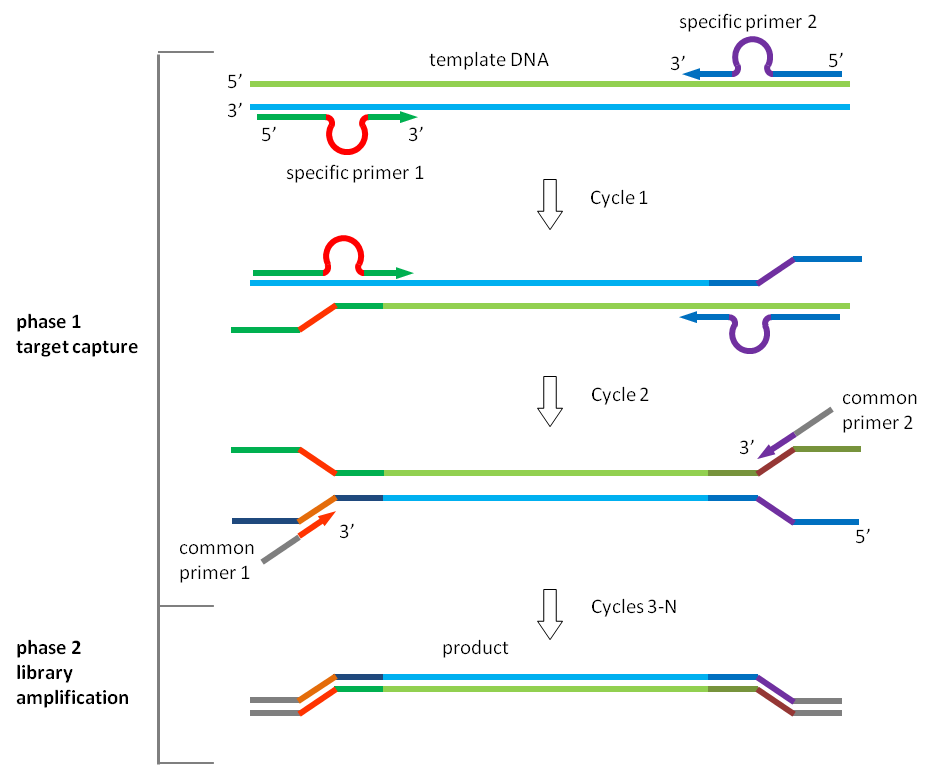VariantPro™ targeted sequencing system is based on a novel multiplex PCR technology that combines two major (patent pending) innovations to facilitate simple operation and high performance in the preparation of targeted sequencing libraries. The two innovations are:
- Omega Primer™ – a novel primer design that fundamentally improves primer specificity and yet is capable of sustaining certain local template variations such as SNPs.
- Relay-PCR™ – an elegant PCR method that combines multiple target capture and monoplex PCR amplification into a single reaction and therefore simplifies targeted sequencing library preparation.
An omega primer consists of three functional sections:
- A 3p arm functions as an initiator in a polymerase extension reaction.
- A 5p arm functions as an anchor attaching to a DNA template.
- A loop separates the two arms. In a relay PCR the loop is used as a priming section for monoplex PCR.
This design has fundamental advantages over conventional primers in the following aspects
- Specificity – A viable omega primer requires specific bindings of both 3p arm and 5p arm. This requirement results in a significant increase of specificity as compared to conventional primers.
- Ability to tolerate certain template variations – In some applications, the 5p arm is intentionally made long so that it stays hybridized to a corresponding template even when a mismatch (e.g. a SNP) is present in the template. This is a useful feature considering that there are 6 million high allele frequency (>1%) SNPs in human genome of 3 billion bp long, an average of 1 SNP in every 50 bp.
- Reduced primer-primer dimer formation – Amplifiable primer-primer dimmers are formed only when 3p arms of two primers are cross-hybridized with at least one primer having its 3’ end complementarily bind to the other primer. Omega primers generally have much shorter 3p arms (16 nt) than that of regular primers (35 nt) therefore have statistically a much less probability of forming the amplifiable primer-primer dimers.
- Native sequence in an amplicon – An amplicon sequencing read consists of native and primer sequence sections. Primer 3p arms are incorporated into amplicons becoming the primer sections. Since omega primers have much shorter 3p arms (16 nt) than that of regular primers (35 nt), omega primer produced amplicons have higher percentage of native sequence sections.
Relay-PCR™ is a new, simple, and robust method of multiplexing PCR. A single PCR run accomplishes two functionally separate reaction phases without any primer removal step, resulting in a significantly simplified, one step workflow. A single pair of common primers and a mixture of multiple pairs of specific primers are added to a genomic DNA sample in a single tube. Both a selection phase, where the genomic targets of interest are captured, and a library amplification phase, will occur during this single PCR reaction.
More importantly, the addition of the common primers induces a profound change to multiplexing PCR by limiting the role of specific primers to only the first two thermo cycles for target replication and enables an automatic switch to common primers in the remaining thermo cycles for library amplification. This arrangement eliminates a significant cause for amplicon to amplicon variations in end product due to priming efficiency variations among specific primers which would be exponentially amplified if used as amplification primers.



